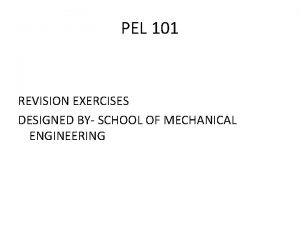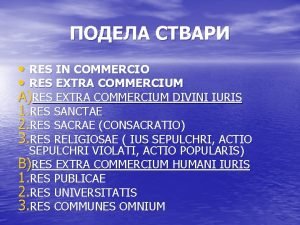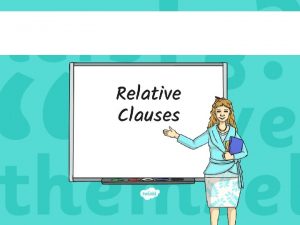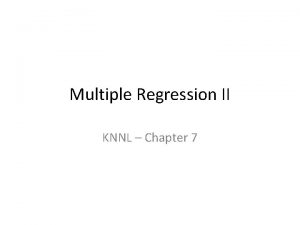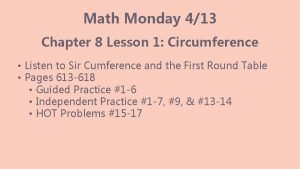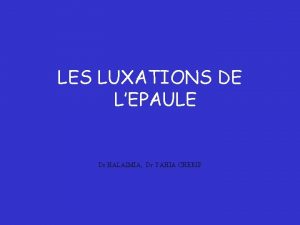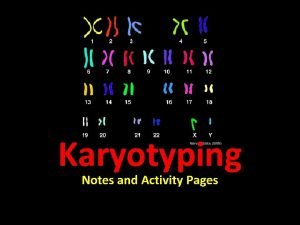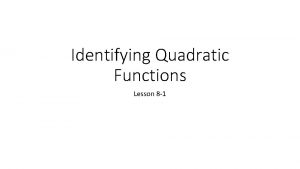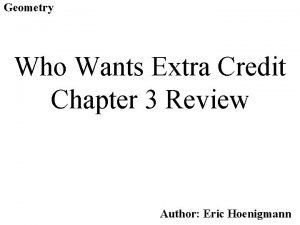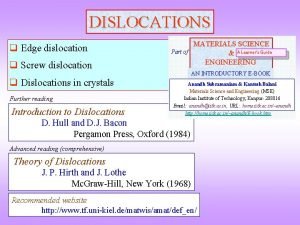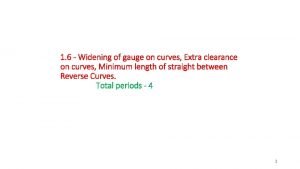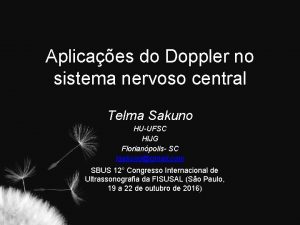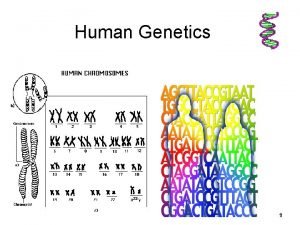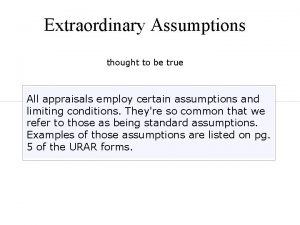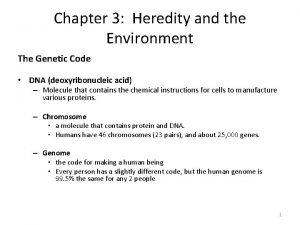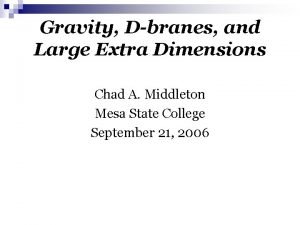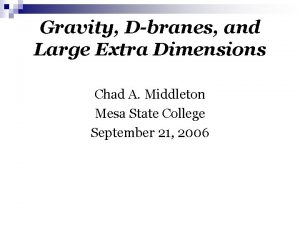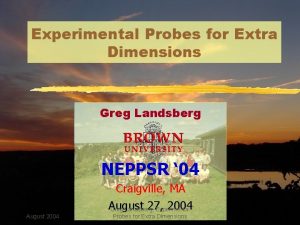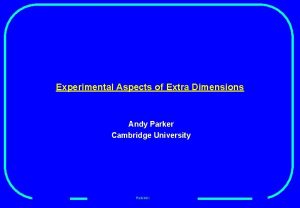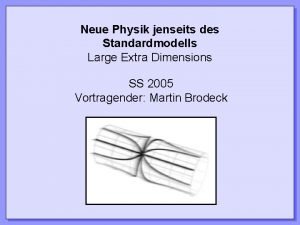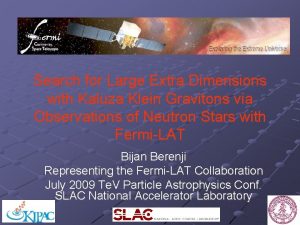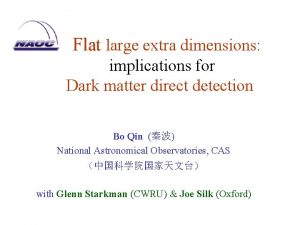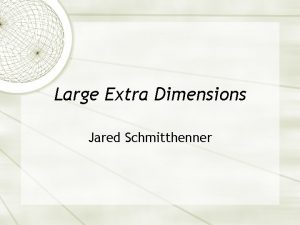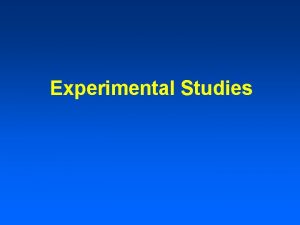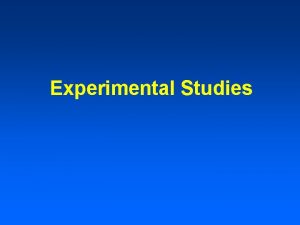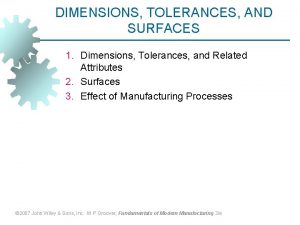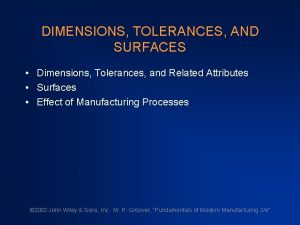Theories with large extra dimensions and their experimental
































































- Slides: 64

Theories with large extra dimensions and their experimental consequences Edward Boos, Vyacheslav Bunichev, Maxim Perfilov, Mikhail Smolyakov, Igor Volobuev (SINP MSU)

QFTHEP'2015 Samara, 26 June 2015 n Introduction Hundred years ago the first physical theory was put forward, in which an attempt was made to use fivedimensional space-time for a unification of electromagnetism and relativistic scalar gravity: Gunnar Nordström, ''Über die Möglichkeit, das elektromagnetische Feld und das Gravitationsfeld zu vereinigen''‚ (On the possibility of unifying the electromagnetic and the gravitational fields) (1914 г. ) 2

QFTHEP'2015 Samara, 26 June 2015 Later this idea was developed by T. Kaluza and O. Klein: Kaluza T. ''Zum Unitätsproblem in der Physik''‚ (On the problem of unity in physics) Sitzungsber. Preuss. Akad. Wiss. Berlin. (Math. Phys. ). 1921. P. 966 -972; Klein O. ''Quantentheorie und fünfdimensionale Relativitätstheorie'', (Quantum theory and five-dimensional theory of relativity) Zeit. Physik. 1926. V. 37. P. 895 -906. 3

QFTHEP'2015 Samara, 26 June 2015 The space-time has an extra space dimension, which is macroscopically unobservable. The unobservability of the extra dimension was explained by its compactness and extremely small size, of the order of the Planck length LPl = 1/MPl 4

QFTHEP'2015 Samara, 26 June 2015 The original Kaluza-Klein model: gravity in fivedimensional space-time E=M 4 x S 1 with action being the five dimensional gravitational constant, being the five-dimensional scalar curvature and the signature of the metric being sign g. MN = (-, +, +), M, N = 0, 1, 2, 3, 4. 5

QFTHEP'2015 Samara, 26 June 2015 The five-dimensional metric g. MN can be decomposed as If g. MN does not depend on the extra dimension coordinate y, then R(4) being the scalar curvature of the four-dimensional space-time M 4 with metric Ɣμν. 6

QFTHEP'2015 Samara, 26 June 2015 In the papers by Kaluza and Klein the field φ was assumed to be constant, and the field Aμ was identified with the electromagnetic field. The theory gives a relation between the five-dimensional (M) and the four-dimensional (MPl) Planck masses: Any field in space-time E=M 4 x S 1 can be expanded in a Fourier series in the coordinate y. 7

QFTHEP'2015 Samara, 26 June 2015 Thus, for a scalar field The Lagrangian in five-dimensional space-time is and the equations of motion look like 8

QFTHEP'2015 Samara, 26 June 2015 The modes φ(n) satisfy the equations Since L is of the order of the Planck length, the observable fields may be only the “zero modes”, i. e. they do not depend on the coordinate of the extra dimension. n For every four-dimensional field there exists a tower of fields with the same quantum numbers and the masses of the order of MPl, which cannot be observed at the energies available nowadays. 9

QFTHEP'2015 Samara, 26 June 2015 1 Large extra dimensions Localization of fields: V. A. Rubakov and M. E. Shaposhnikov, “Do We Live Inside A Domain Wall? ” Phys. Lett. 125 (1983) 136. “Extra Space-Time Dimensions: Towards A Solution Of The Cosmological Constant Problem”, Phys. Lett. 125 (1983) 139. 10

QFTHEP'2015 Samara, 26 June 2015 The fields of the SM can be localized on a domain wall in a multidimensional space. If the thickness of the domain wall goes to zero, then it turns into a membrane, or just a “brane”. n ADD scenario N. Arkani-Hamed, S. Dimopoulos and G. R. Dvali, “The hierarchy problem and new dimensions at a millimeter”, Phys. Lett. B 429 (1998) 263 11

QFTHEP'2015 Samara, 26 June 2015 A single brane without tension (i. e. energy density) in a space-time with an arbitrary number of compact extra dimensions. The scenario provides a solution to the hierarchy problem: it gives a strong gravity in the multidimensional space-time and a weak gravity on the brane n The approximation of the zero brane tension turns out to be rather too rough, and the proper gravitational field of the brane cannot be taken into account perturbatively. 12

QFTHEP'2015 Samara, 26 June 2015 n For the equations of Einstein gravity in space–time with compact extra dimensions to be consistent, there should exist at least two branes with tension, and the number of extra dimensions can be either one or two. L. Randall and R. Sundrum, “A large mass hierarchy from a small extra dimension”, Phys. Rev. Lett. 83 (1999) 3370 13

QFTHEP'2015 Samara, 26 June 2015 Sean M. Carroll, Monica M. Guica, “Sidestepping the cosmological constant with football shaped extra dimensions. e-Print: hep-th/0302067 In Einstein gravity it is impossible to find braneworld solutions with more than two extra dimensions. A possible way out is to pass to Lovelock gravity D. Lovelock, "The Einstein tensor and its generalizations", J. Math. Phys. 12 (1971) 498 - 501. 14

QFTHEP'2015 Samara, 26 June 2015 2 The Randall-Sundrum model Two branes with tension at the fixed points of the orbifold S 1/Z 2: 15

QFTHEP'2015 Samara, 26 June 2015 The solution for the background metric: The parameters k, Λ и λ 1, 2 satisfy the fine tuning conditions: The linearized gravity is obtained by the substitution 16

QFTHEP'2015 Samara, 26 June 2015 The field h. MN can be transformed to the gauge The field φ(x) is called the radion field. The distance between the branes along the geodesic x = const 17

QFTHEP'2015 Samara, 26 June 2015 The metric in the zero mode approximation looks like Substituting this metric into the action and integrating over the coordinate of the extra dimension one gets an effective action Galilean coordinates: gμν = diag(-1, 1, 1, 1). 18

QFTHEP'2015 Samara, 26 June 2015 Coordinates {x} are Galilean for c=0, 19

QFTHEP'2015 Samara, 26 June 2015 Coordinates {x} are Galilean for c = - k. L, 20

QFTHEP'2015 Samara, 26 June 2015 The hiearrchy problem is solved, if M ~ k ~ 1 Te. V и k. L~ 35. There appears a tower of tensor fields on the brane with the lowest mass of the order of M and the coupling to the SM fields of the order of 1/M. The coupling of the radion to matter on the brane is too strong and contradicts the experimental restrictions even at the level of classical gravity. The Randall-Sundrum model must be stabilized! 21

QFTHEP'2015 Samara, 26 June 2015 3 n Stabilized Randall-Sundrum model Stabilization mechanisms: W. D. Goldberger and M. B. Wise, “Modulus stabilization with bulk fields”, Phys. Rev. Lett. 83 (1999) 4922 O. De. Wolfe, D. Z. Freedman, S. S. Gubser and A. Karch, “Modeling the fifth dimension with scalars and gravity”, Phys. Rev. D 62 (2000) 046008 22

QFTHEP'2015 Samara, 26 June 2015 The second model is more consistent. We consider such values of the model parameters that the background metric of the stabilized model is close to that of the unstabilized model. The physical degrees of freedom of the model in the linear approximation were isolated in the paper E. E. Boos, Y. S. Mikhailov, M. N. Smolyakov and I. P. Volobuev, “Physical degrees of freedom in stabilized brane world models”, Mod. Phys. Lett. A 21 (2006) 1431 23

QFTHEP'2015 Samara, 26 June 2015 They are: n tensor fields bμνn(x), n=0, 1, … with masses mn (m_0 = 0) and wave functions in the space of extra dimension ψn(y), n scalar fields φn(x), n=1, 2, … with masses μn and wave functions in the space of extra dimension gn(y). In the Standard Model extension based on the stabilized Randall-Sundrum model there appear new interactions of the SM fields described by the Lagrangian Tμν being the energy-momentum tensor of the SM. 24

QFTHEP'2015 Samara, 26 June 2015 4 Tensor sector: interactions due to Kaluza-Klein gravitons At low energies these interactions lead to contact interactions of SM fields m 1 and Λπ being the mass and the coupling constant of the first tensor mode and the constant δ describing the contribution of the scalar modes. For M ≈ 2 Te. V, k ≈ 1 Te. V, k L = 35 and the mass of the first scalar mode of the order of 2 Te. V these parameters turn out to be 25

QFTHEP'2015 Samara, 26 June 2015 In the first approximation the effective interaction Lagrangian includes a sum of various 4 -particle effective operators (not only 4 -fermion, but also 2 -fermion-2 -boson and 4 -boson), which are invariant with respect to the SM gauge group and lead to a well defined phenomenology. Various processes due to this Lagrangian were studies with the help of the Comp. HEP package in the paper E. E. Boos, V. E. Bunichev, M. N. Smolyakov and I. P. Volobuev, “Testing extra dimensions below the production threshold of Kaluza-Klein excitations” Phys. Rev. D 79: 104013, 2009 ar. Xiv: 0710. 3100 v 4 [hep-ph]. 26

QFTHEP'2015 Samara, 26 June 2015 27

QFTHEP'2015 Samara, 26 June 2015 28

QFTHEP'2015 Samara, 26 June 2015 n The restrictions on the coupling constant for which the extra dimension cannot be observed at the LHC: n The lowest value of the parameter Λπ , for which the extra dimension does not manifest itself, can be found from the demand that the resonance width is lesser than its mass, i. e. Γ 1 = m 1/ξ , where ξ >1: 29

QFTHEP'2015 Samara, 26 June 2015 n In a similar way one can consider the situation, where the mass of the first mode lies in the accessible energy range. In this case the contribution of the first mode can be taken into account explicitly and the contribution of all the other modes, starting from the second one, can be again described by the effective contact interaction. 30

QFTHEP'2015 Samara, 26 June 2015 31

QFTHEP'2015 Samara, 26 June 2015 32

QFTHEP'2015 Samara, 26 June 2015 33

QFTHEP'2015 Samara, 26 June 2015 5 Scalar sector: radion interactions and Higgs-radion mixing n The radion field is a combination of the metric fluctuations in the extra dimension and of the fluctuations of the stabilizing scalar field. Due to its origin, it couples to the trace of the energy-momentum tensor of the Standard Model: 34

QFTHEP'2015 Samara, 26 June 2015 In the paper E. Boos, S. Keizerov, E. Rahmetov and K. Svirina, “Higgs boson-radion similarity in production processes involving off-shell fermions” Phys. Rev. D 90 (2014) 9, 095026 it was shown that this interaction Lagrangian leads to the same production and decay properties of a single radion as those of the Higgs boson. The radion and the Higgs boson having the same quantum numbers, the radion field and its excitations can mix with the Higgs field, if they are coupled. 35

QFTHEP'2015 Samara, 26 June 2015 n Higgs-radion coupling in the unstabilized Randall. Sundrum model arising due to a Higgs-curvature term on the brane was introduced in the paper G. F. Giudice, R. Rattazzi and J. D. Wells Graviscalars from higher dimensional metrics and curvature Higgs mixing Nucl. Phys. B 595 (2001) 250 It looks like , In the linearized theory H(x) denoting the Higgs field. 36

QFTHEP'2015 Samara, 26 June 2015 The Higgs-curvature term gives rise to the interaction term , , which leads to a Higgs-radion mixing, and to a term with the Fierz-Pauli Lagrangian that affects the boundary conditions for the tensor fields. 37

QFTHEP'2015 Samara, 26 June 2015 n In stabilized brane world models, instead of the Higgscurvature term, one can introduce an interaction between the stabilizing scalar field and the Higgs field of the form that replaces the Higgs potential and leads to spontaneous symmetry breaking on our brane. This term gives rise to an interaction of the physical Higgs boson field σ(x) with the radion field φ1(x) and its Kaluza. Klein tower. 38

QFTHEP'2015 Samara, 26 June 2015 At low energies the heavy Kaluza-Klein scalar modes can be integrated out, the interaction between the Higgs field σ(x) and the radion field φ1(x) can be diagonalized by a rotation , which gives an effective Lagrangian for the interaction of the Higgs-dominated field h(x) and the radion-dominated field r(x) with the fields of the Standard Model. 39

QFTHEP'2015 Samara, 26 June 2015 he The parameter c takes into account the contributions of the integrated out heavy scalar modes and the conformal anomaly is explicitly given by 40

QFTHEP'2015 Samara, 26 June 2015 We have studied two a priori possible scenarios that the scalar state discovered at 125 Ge. V is either a Higgsdominated state or a radion-dominated state. In our analysis we used only two signal strengths corresponding to the channels gg → ɣɣ and gg → ZZ*. E. Boos, V. Bunichev, M. Perfilov, M. Smolyakov and I. Volobuev, “Higgs-radion mixing in stabilized brane world models, ” ar. Xiv: 1505. 05892 [hep-ph]. 41

QFTHEP'2015 Samara, 26 June 2015 Exclusion contours for the combined χ2 fit in the (mr , sinθ ) plane for Λr = 3 Te. V 42

QFTHEP'2015 Samara, 26 June 2015 Exclusion contours for the combined χ2 fit in the (mr , sinθ ) plane Λr = 5 Te. V 43

QFTHEP'2015 Samara, 26 June 2015 Exclusion contours for the combined χ2 fit in the (mh , sinθ ) plane Λr = 3 Te. V 44

QFTHEP'2015 Samara, 26 June 2015 Exclusion contours for the combined χ2 fit in the (mh , sinθ ) plane Λr = 5 Te. V 45

QFTHEP'2015 Samara, 26 June 2015 6 Universal Extra Dimensions and processes with the excitations of the SM gauge bosons If the SM gauge bosons can propagate in the bulk, there also arise KK towers of their excitations, which may produce similar effects. 46

QFTHEP'2015 Samara, 26 June 2015 Single top production 47

QFTHEP'2015 Samara, 26 June 2015 48

QFTHEP'2015 Samara, 26 June 2015 49

QFTHEP'2015 Samara, 26 June 2015 50

QFTHEP'2015 Samara, 26 June 2015 51

QFTHEP'2015 Samara, 26 June 2015 52

QFTHEP'2015 Samara, 26 June 2015 53

QFTHEP'2015 Samara, 26 June 2015 n Drell-Yan processes 54

QFTHEP'2015 Samara, 26 June 2015 n Here we have also to take into account the processes with the Kaluza-Klein gravitons 55

QFTHEP'2015 Samara, 26 June 2015 56

QFTHEP'2015 Samara, 26 June 2015 57

QFTHEP'2015 Samara, 26 June 2015 58

QFTHEP'2015 Samara, 26 June 2015 59

QFTHEP'2015 Samara, 26 June 2015 60

QFTHEP'2015 Samara, 26 June 2015 61

QFTHEP'2015 Samara, 26 June 2015 7 Conclusion n The Standard Model extension based on the stabilized Randall-Sundrum model is phenomenologically acceptable. If the values of the fundamental parameters lie in the Te. V energy range, then the effects due to the massive modes can be observed in collider experiments, in particular, in the Higgs boson decay. n The LHC data give an estimate for the parameter Λπ: 62

QFTHEP'2015 Samara, 26 June 2015 n In the case, where the centre of mass energy is above the production threshold of the first mode, the effective contact interaction induced by the infinite towers of gravitons or KK excitations of the SM particles should also be taken into account, because they lead to nontrivial interference effects. n An observation of the interference between the first KK graviton or SM particle resonance and the rest of its KK tower should be considered as a strong argument in favour of the extra dimensions hypothesis. 63

QFTHEP'2015 Samara, 26 June 2015 Thank you! 64
 School revision 101
School revision 101 Senin aşkın bana extra large
Senin aşkın bana extra large Experimental vs non experimental
Experimental vs non experimental What is quasi experimental research
What is quasi experimental research Disadvantages of experimental research
Disadvantages of experimental research Experimental vs nonexperimental
Experimental vs nonexperimental Experimental vs non experimental
Experimental vs non experimental Education theorists and their theories
Education theorists and their theories Count the day lost questions and answers
Count the day lost questions and answers Slide todoc.com
Slide todoc.com What is the romeo and juliet prologue in modern english?
What is the romeo and juliet prologue in modern english? Radazin herbicid
Radazin herbicid Extra information clauses
Extra information clauses Res extra commercium
Res extra commercium Pure herbs lotion
Pure herbs lotion Res in comercio
Res in comercio Parts of circumferential clasp
Parts of circumferential clasp Nnn special broadcast
Nnn special broadcast Extra information clauses
Extra information clauses Apa itu guest ledger
Apa itu guest ledger Podział rzeczy
Podział rzeczy Extra sum of squares multiple regression
Extra sum of squares multiple regression 30 dollar riddle answer
30 dollar riddle answer Mfl games
Mfl games Lesson 2 reteach area of circles answer key
Lesson 2 reteach area of circles answer key Luxation extra coracoidienne
Luxation extra coracoidienne Xyy syndrome pictures
Xyy syndrome pictures Operazioni triangolari extra ue
Operazioni triangolari extra ue Res extra commercium
Res extra commercium Lesson 8 quadratic functions page 339
Lesson 8 quadratic functions page 339 Extra y chromosome
Extra y chromosome In geometry
In geometry Males with extra y chromosome
Males with extra y chromosome B2 test
B2 test Extra lesson antroposofia
Extra lesson antroposofia Trabajo extra clase
Trabajo extra clase Extra half plane
Extra half plane Inter intra extra
Inter intra extra Extaramove
Extaramove Extra clearance on curves
Extra clearance on curves Res extra commercium
Res extra commercium Ira pré renal renal e pós renal
Ira pré renal renal e pós renal Bracing in partial denture
Bracing in partial denture Open sans extra bold
Open sans extra bold Spotted sandpiper
Spotted sandpiper The extra dopamine released during drug use can
The extra dopamine released during drug use can Dermatolog warszawa prywatnie
Dermatolog warszawa prywatnie Extra markup html
Extra markup html Elogio a epicuro
Elogio a epicuro Coleção extra-axial benigna da infância
Coleção extra-axial benigna da infância Montserrat extra
Montserrat extra Swyer syndrome
Swyer syndrome Extra credit anime
Extra credit anime Extra x chromosome
Extra x chromosome Appraisal extraordinary assumption
Appraisal extraordinary assumption Infraduodenal part
Infraduodenal part Four extra letters spanish alphabet
Four extra letters spanish alphabet Extra topicality
Extra topicality Hora extra
Hora extra Extra x
Extra x Chapter 14 human heredity
Chapter 14 human heredity Choroid plexus papilloma
Choroid plexus papilloma Rheumatoid arthritis extra-articular manifestations
Rheumatoid arthritis extra-articular manifestations Think central science fusion
Think central science fusion Us extra fancy
Us extra fancy
